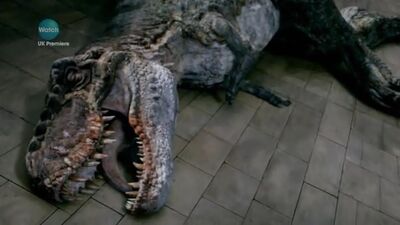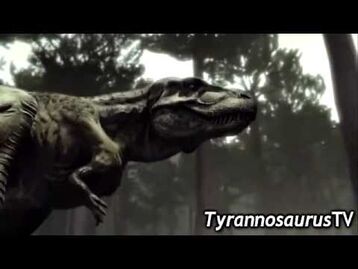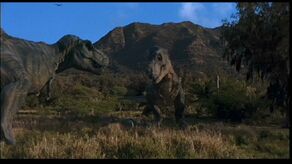
T-Rex in Primeval
Tyrannosaurus Rex or T-Rex meaning "tyrant lizard", is a species of coelurosaurian theropod dinosaur. Tyrannosaurus is a fixture in popular culture. It lived throughout what is now western North America, at the time an island continent termed Laramidia, with a much wider range than other tyrannosaurids. Fossils are found in a variety of rock formations dating to the Maastrichtian age of the upper Cretaceous Period, 67 to 65.5 million years ago.[1] It was among the last non-avian dinosaurs to exist before the Cretaceous–Paleogene extinction event. Like other tyrannosaurids, Tyrannosaurus was a bipedal carnivore with a massive skull balanced by a long, heavy tail. Relative to the large and powerful hindlimbs, Tyrannosaurus forelimbs were small, though unusually powerful for their size, and bore two clawed digits. Although other theropods rivaled or exceeded Tyrannosaurus rex in size, it was the largest known tyrannosaurid and one of the largest known land predators, measuring up to 12.8 m (42 ft) in length,[2] up to 4 metres (13 ft) tall at the hips,[3] and up to 6.8 metric tons (7.5 short tons) in weight.[4] By far the largest carnivore in its environment, Tyrannosaurus rex may have been an apex predator, preying upon hadrosaurs and ceratopsians, although some experts have suggested it was primarily a scavenger. The debate over Tyrannosaurus as apex predator or scavenger is among the longest running in paleontology.

T-Rex in Primeval
More than 30 specimens of Tyrannosaurus rex have been identified, some of which are nearly complete skeletons. Soft tissue and proteins have been reported in at least one of these specimens. The abundance of fossil material has allowed significant research into many aspects of its biology, including life history and biomechanics. The feeding habits, physiology and potential speed of Tyrannosaurus rex are a few subjects of debate. Its taxonomy is

T-Rex from Clash of the Dinosaurs
also controversial, with some scientists considering Tarbosaurus bataar from Asia to represent a second species of Tyrannosaurus and others maintaining Tarbosaurus as a separate genus. Several other genera of North American tyrannosaurids have also been synonymized with Tyrannosaurus.
- Kingdom: Animalia
- Phyllum: Chordata
- Class: Reptilia
- Order: Saurischia

Young T-Rexes in Prehistoric Park
- Family: Tyrannosauridae
- Genus: Tyrannosaurus
- Species: Rex
- Subspecies: --
- Common Name: T-Rex
- Temporal Range: Late Cretaceous Epoch
Appearances[]
- Walking with Dinosaurs
- Discovery Channel Documentaries
- Animal Armageddon
- Primeval
- Jurassic Park
- Prehistoric Park
Mentions[]
Description[]
Although Tyrannosaurus rex was larger than the well known Jurassic theropod Allosaurus, it was slightly smaller than two other Cretaceous carnivores, Spinosaurus and Giganotosaurus.
The largest known Tyrannosaurus rex skulls measure up to 5 feet (1.5 m) in length.[16] Large fenestrae (openings) in the skull reduced weight and provided areas for muscle attachment, as in all carnivorous theropods. But in other respects Tyrannosaurus's skull was significantly different from those of large n

T-Rex in Walking with Dinosaurs
on-tyrannosauroid theropods. It was extremely wide at the rear but had a narrow snout, allowing unusually good binocular vision.[17][18] The skull bones were massive and the nasals and some other bones were fused, preventing movement between them; but many were pneumatized (contained a "honeycomb" of tiny air spaces) which may have made the bones more flexible as well as lighter. These and other skull-strengthening features are part of the tyrannosaurid trend towards an increasingly powerful bite, which easily surpassed that of all non-tyrannosaurids.[19][20][21] The tip of the upper jaw was U-shaped (most non-tyrannosauroid carnivores had V-shaped upper jaws), which increased the amount of tissue and bone a tyrannosaur could rip out with one bite, although it also increased the stresses on the front teeth.

